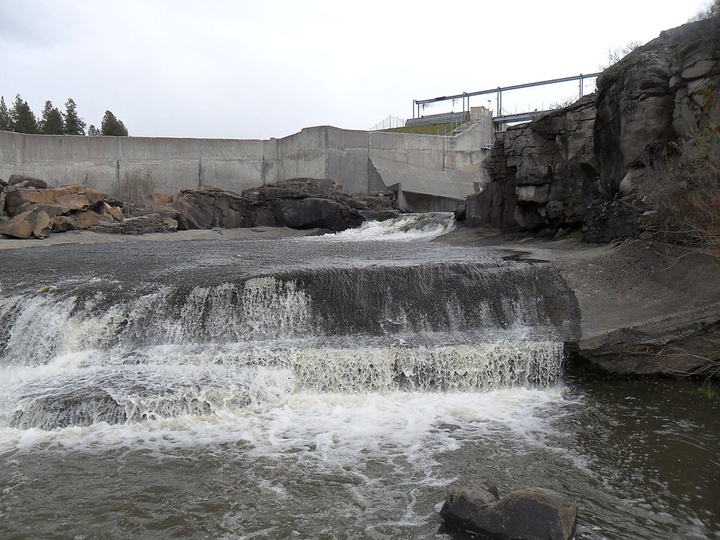Jessica Cejnar / Monday, July 29, 2019 @ 2:42 p.m.
Nonprofit Submits Revisions on Klamath Dam Removal Plan to Feds, Pushes Back Project Start Date

JC Boyle Dam, one of four along with Copco 1, Copco2 and Iron Gate, slated for removal from the Klamath River. Wikimedia Commons
The nonprofit organization tasked with dam removal on the Klamath River submitted a key component of the project to the Federal Energy Regulatory Commission on Monday.
However, the Klamath River Renewal Corporation has moved the estimated date it plans to begin drawdown fo the reservoirs behind the dams back by about a year. Rather than draining the reservoirs starting in January 2021, KRRC and its contractor, Fairfield-based Kiewit Infrastructure West Co., will shoot for January 2022, said KRRC spokesman Matt Cox.
“We have a drawdown window where we can draw the reservoirs down during a period between January and March of whatever year,” Cox said Monday. “That’s a biologically dormant time of year already and there’s a lot of flow and sediment going down the river. It’s the least disruptive time, but then our contractor needs a certain amount of time to prepare.”
Cox said KRRC’s timeline for the project depends on how long it takes FERC to decide whether to transfer the hydroelectric license for the dams from current owner PacifiCorp to the nonprofit. KRRC is also asking FERC to approve its application to surrender the license, at which time it will cease to operate as a hydroelectric project.
On Monday, KRRC submitted a revised definite plan on the dam removal project to the Federal Energy Regulatory Commission, or FERC. These revisions include an updated cost estimate for the project and a demonstration that KRRC has enough money to finish it, according to a press release from the nonprofit. Revisions also include developing a risk management plan that includes insurance, performance bond and indemnity coverage to offset short- and long-term project effects, according to the press release.
Removing the J.C. Boyle, Copco No. 1, Copco No. 2 and Iron Gate Dams, currently owned by PacifiCorp, will cost an estimated $434 million, according to the news release. KRRC has a $450 million budget.
Part of that budget, $200 million, came from a PacifiCorp surcharge to its utility customers. California also ponied up an additional $250 million in Prop 1 water bond dollars.
KRRC submitted its license transfer and surrender application to FERC in 2016 and its definite plan in 2018. At FERC’s direction, KRRC also convened an independent board of consultants to analyze its work and provide feedback, according to the news release.
Before submitting its revised definite plan to FERC, KRRC announced Wednesday that it had hired a subcontractor to spearhead the restoration work once the dams are gone. Though he said it’s too early to say what exactly they’ll do, Resource Environmental Solutions LLC will vegetate lands exposed once the reservoirs are drained, Cox said.
“They’ll be determining what sort of restoration undertakings, work, pre-project,” he said. “You have right now these reservoirs and they’re going to recede back to a natural river channel. There’ll be exposed lands, (RES) will be re-vegetating those lands.”
RES recently restored 17,000 acres into a “functioning native ecosystem” for the North Texas Municipal Water District, according to a KRRC press release. RES has worked in roughly 20 states and has improved more than 300 miles of streams, restored more than 50,000 acres and planted more than 15 million trees, according to the news release.
Meanwhile, in a Facebook post, the Yurok Tribe praised KRRC’s work so far toward removing the dams in an effort to restore quality habitat for Klamath River salmon.
“The KRRC has done a tremendous amount of work to ensure that this dam removal will be done right and they have earned the complete confidence of the Yurok Tribe,” said Yurok Tribal Chairman Joseph L. James. “Restoring the Klamath River will not only benefit the tribe and local communities up and down the river, but because the Klamath is a national treasure, it will benefit the nation as a whole. It is time for the salmon to go home.”
KRRC was created in 2016 as part of the amended Klamath Hydroelectric Settlement Agreement. Signatories of the KHSA include the states of California and Oregon, local governments, tribal nations, PacifiCorp, irrigators and several conservation and fishing groups.
To view KRRC’s updated definite plan, visit www.klamathrenewal.org/definite-plan.
CLICK TO MANAGE